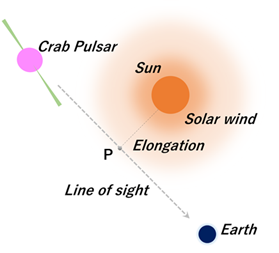Diagnostics of coronal plasma at the current solar minimum using a cosmic lighthouse
2022-01-20
A fast-spinning celestial object which emits radio waves, called a pulsar, is located at the center of the Crab nebula. When a pulsar is observed at the earth, radio pulses are received periodically like a lighthouse beacon. The signal from this cosmic lighthouse contains information of the space plasma density along the ray path. We performed observations of the Crab pulsar using a large radio-telescope at the Toyokawa observatory, when the line-of-sight for it approached the sun, and determined the distribution of plasma density in the vicinity of the sun, where in situ measurements are difficult, from obtained data. The solar wind density is known to significantly decrease in response to a marked decline in the solar activity in the Cycle 24, and therefore what is happening in the near-sun plasma is an interesting subject. The results obtained here showed that the coronal plasma distribution at the current (Cycle 24/25) solar minimum is similar to those observed at past minima, and this fact suggests that the coronal plasma density recovered from a significant reduction in the Cycle 24.
Reference
Tokumaru, M., Maeda, R., Tawara, K. et al. Coronal Density Measurements Using Giant Radio Pulses of the Crab Pulsar at the Cycle 24/25 Minimum. Sol Phys 297, 10 (2022). https://doi.org/10.1007/s11207-021-01939-6
Figure
Measurements of coronal plasma density using radio waves from the Crab pulsar



